You could have the perfect niche, sell the best products, and develop the best eCommerce site, but if you fail to engage with your audience then you will fail to convert clicks and purchases. To help you understand how to build a better online store we have developed 6 eCommerce marketing mistakes that you need to avoid if you want to reach your business goals!
1. Not Including A Sense Of Urgency
Urgency and scarcity are phenomena that makes people take action whenever a product or service is limited. Like basic economics, humans interpret the ability to secure a resource whenever they determine how attractive and valuable that product is based on how quickly it is to get that product or service.
Much recent psychology research has shown that consumers think that a product or service is more alluring when it is rare. You can use this knowledge to your benefit as you write content for your eCommerce store by creating a sense of urgency in your readers to increase the chances that they will convert.
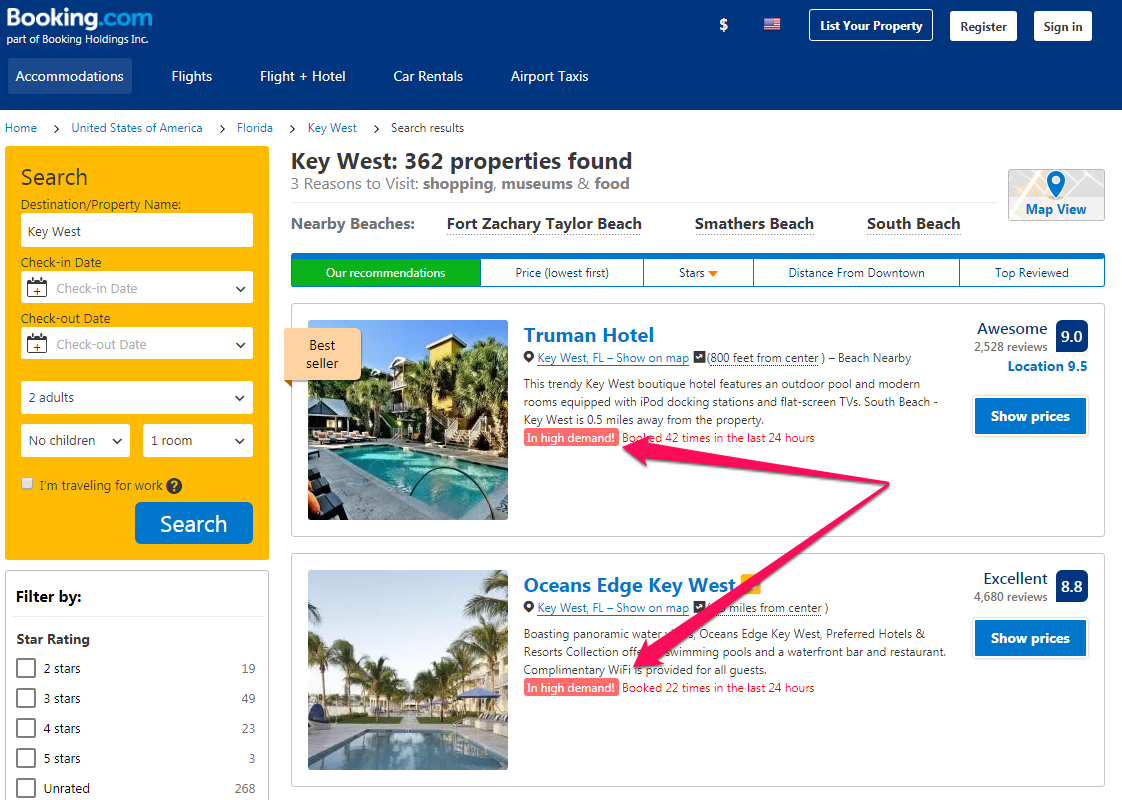
Booking.com does a great job building urgency and scarcity with their rental properties. You can see that they put a giant “In High Demand” in red and white lettering. This catches your eye, and with the red color, readers are more likely to complete conversion at the time they see the offers on their screen.
2. No Content Personalization
If you have an eCommerce store, then you know that you are battling against the larger shops like Amazon, Walmart, and niche-specific stores. Along with having to win attention for consumers from those big online stores, you also have to convert traffic that comes to your site.
If you want to keep your customers engaged with your content and boost higher conversion rates, then you need to make sure that you speak to each customer that comes to your site. Personalized content on your eCommerce site is more than merely changing the shipping costs for customers in different geolocations or changing “Related Items” based on what each customer has looked at in the past.
Indeed personalized content will change based on the user experience and engagement data whether your customers are logged-in or are browsing your site as an anonymous user. Using cookies and other technologies, you will be able to change how consumers experience your site’s content in many ways like:
• Recommended products. You can customize product reviews based on the search history of your customers. This level of personalization can be difficult, but if you pull this off, you will be able to make each customer see relevant products for them to browse.
• Customized email marketing CTAs. You can use event-driven email signups to customize the CTAs that your customers see based on the products they have viewed. You can either offer discounts on a category or provide email signup based on specific segments to improve conversion rates.
• Retargeting Ads. You can cookie your customers based on the products and pages they visit so when they leave your site you can deliver custom remarketing ads for specific products. Retargeting is based on behavioral data, so make sure you optimize your product and category pages on your online store to create a personalized website experience.
These are just a few suggestions to personalize content on your site, but you can also personalize landing pages. Personalizing landing pages on your online store can drive more testing opportunities and customize content around each product or category page.
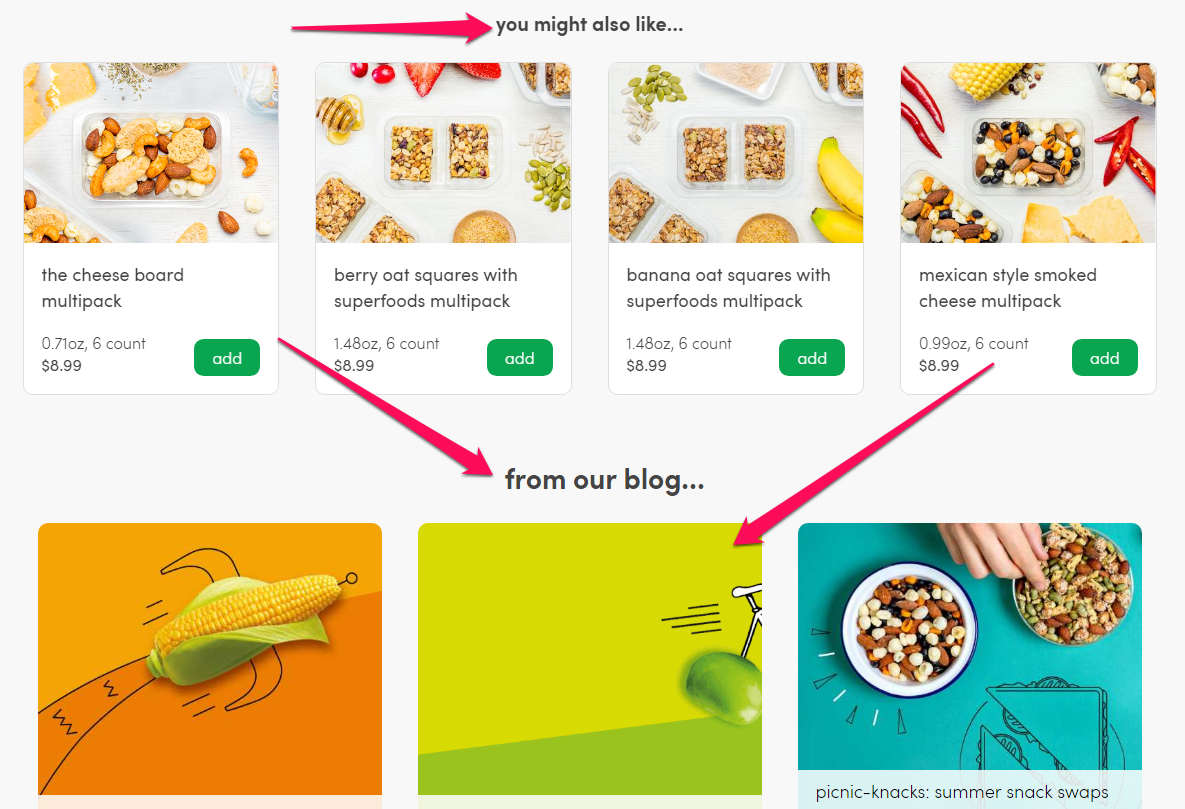
Graze does a great job personalizing content. Based on the snacks and other variables that you choose will deliver different “You might also like” products and even chances the blog posts you see at the bottom of their products.
3. Not Making Your Customers Feel Like They Already Bought From You
Many eCommerce stores look at their product descriptions as a way to just relay features of that product to their audience. However, this approach to product descriptions misses a significant opportunity to build a lifestyle around the product by telling a story and making strong buying signals.
Great product descriptions should include keywords to help your content get found by Google, but you should also include sensory words to help build a story around the product. Right eCommerce copywriting will let your audience picture themselves using your product because this can improve conversion rates across the board. Here are some tips to help you accomplish this in your product descriptions:
• Use words like “Imagine,” “picture yourself,” and other similar terms.
• Let your customers imagine themselves using your products and the enjoyment they will experience.
• Use future and present tenses in your content to make your customers feel like they already bought your product.
• Include terms that reference touch, smell, taste, and sound to make your product descriptions more real.
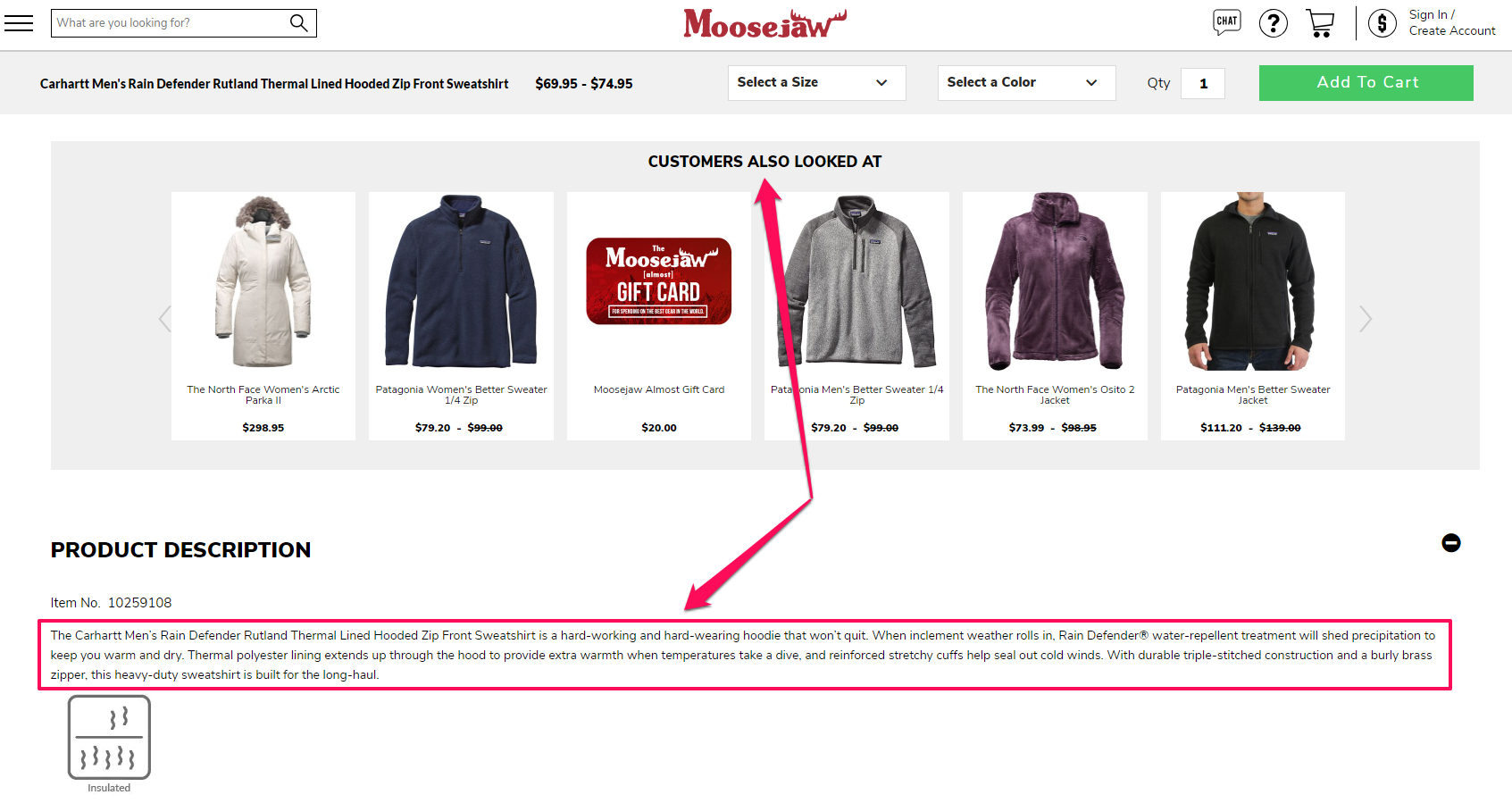
Moosejaw does a great job making their customers feel like they already bought from them. Their copywriting is focused on the needs of their customers first, and then talks about technical details about each product after their customers know they like the item and want to make a purchase.
4. Not Including Questions & Answers For Products
Your audience asks a question every time they type something into Google. This is especially true for eCommerce stores since you sell physical goods meant to address the needs and issues of your customers.
If you want to harness the power of organic SEO while driving qualified leads to your site, then you should use questions and answers in your eCommerce product pages. You can also use this approach to eCommerce copywriting in long-form pages like guides and overview pages.
Often times using exact-match questions in your H2 tags is a great way to get found by Google and provide context to your audience as they read through your content. You will build trust with your audience as your readers see the exact questions they were asking in Google on your site, and your answers will guide them towards the products and solutions they need to meet their needs.
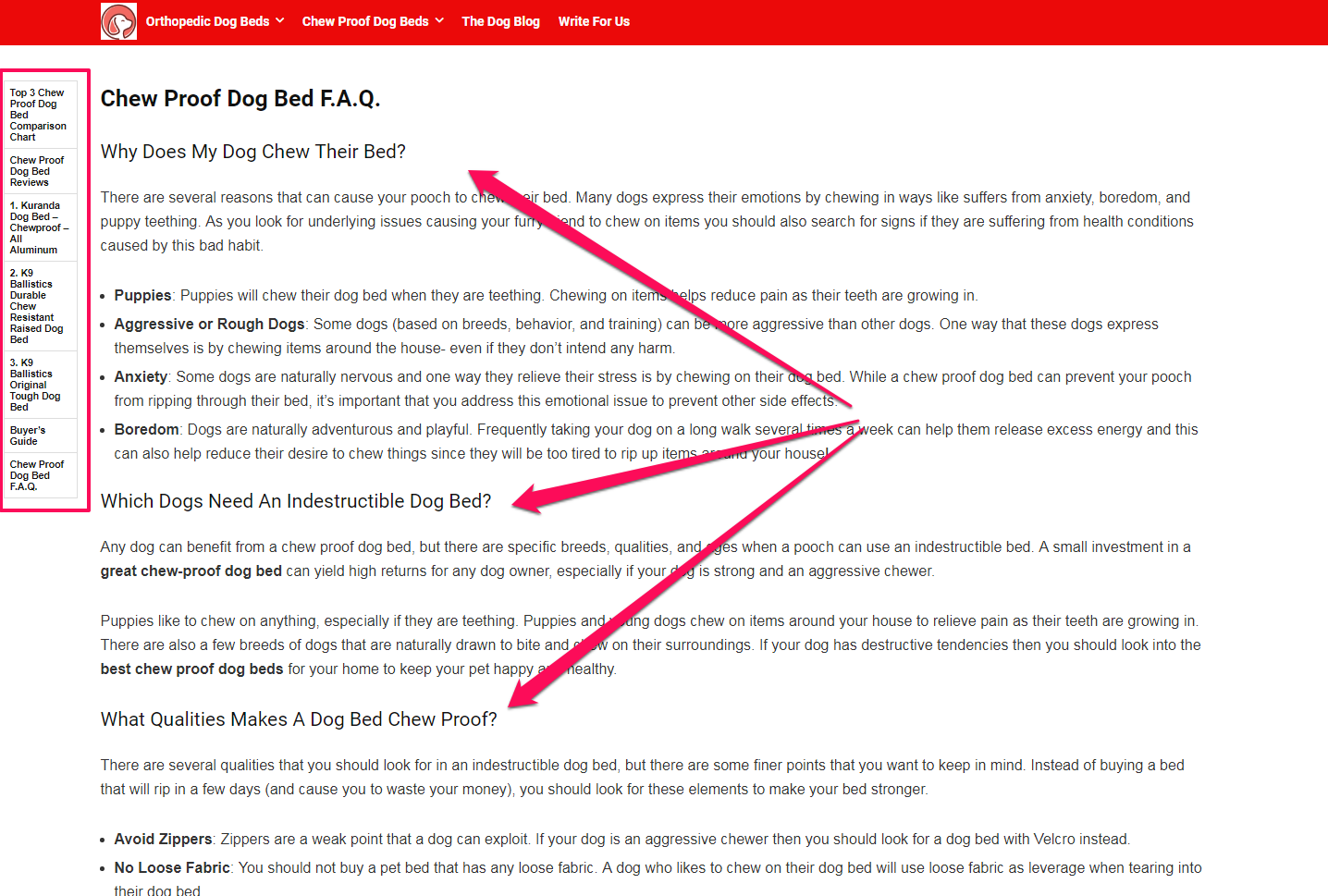
Dogsupplies4me focuses on writing long-form content for their customers. Not only does this approach help with ranking in Google, but it also helps answer questions and keep readers on their site for longer periods. This site uses questions and answers in their content for large guides like their best indestructible dog bed buyer guide/review.
5. Not Focusing On The Benefits
While it may seem counterintuitive, the truth is that you want to focus on the benefits that your products offer more than the focus on the product itself. It is easy to focus too much on the products that you provide on your site, and while this is normal, it can have a negative impact on your eCommerce store.
Your buyers aren’t interested in the features and specs of your products until they understand how those products will help them. One of the best ways to position your product and establish the value of your products is to highlight the problems that your customers are trying to solve and how your store can help your audience live a better life.
While it is easy to only focus on the specifications and other technical details, the truth is that your audience won’t give you the time to convert if you don’t show the value and benefits your products offer.

Ugmonk does a great job of showing the benefits of their product. For example, they use descriptive terms to talk about their modular organizer that helps consumers cut through the clutter. Instead of starting off with specs and technical details, they talk about what the product does and then dive into the details later.
6. Lacking Social Proof
Consumers are hardwired to be skeptical of online products. The truth is that your audience is more concerned about making the wrong purchase than they are about not making a purchase at all!
You can use the power of social proof to help your audience overcome their distrust of your eCommerce store, and this approach can help you guide your customers in the direction of conversion. You can use signals through social proof to apply peer pressure and build trust with your prospects since many people believe that products are valuable if other people confirm this assumption.
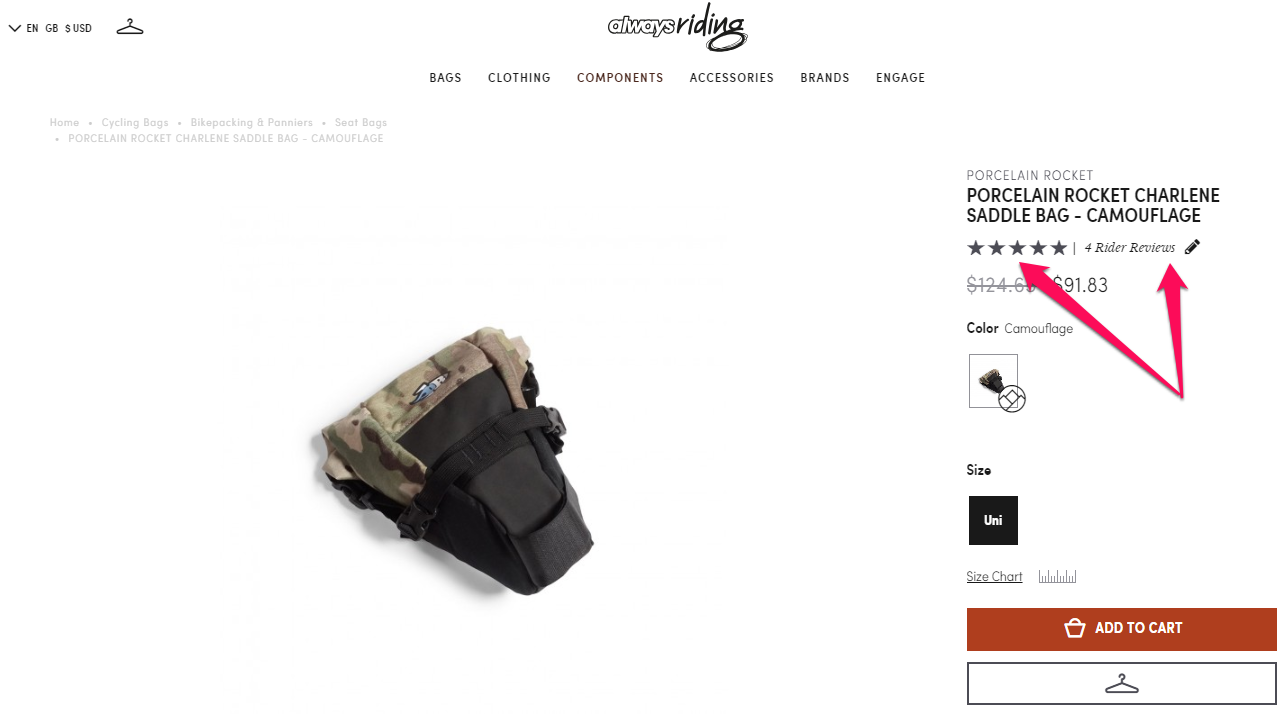
Always Riding has great social proof front and center on all of their product listings. Their star rating system helps to reinforce the value of the product, and their “Rider Reviews” helps build trust with potential customers.
7. Writing Content For Your eCommerce Store
If you are struggling to grow your online store or hit your business goals then you should consider using the above tips. Not only will improved copywriting help you connect and engage with your customers, it will also help you boost your sales. Take some time to implement these suggestions and see how your business grows today!
Never miss a story..!!
Grab the Latest SEO & SMO News, Tips, Updates & Trends..!!
See Our Blogcenter
Want to share your thoughts with our readers? Learn how to become a contributing author
Photo by Mikhail Pavstyuk



